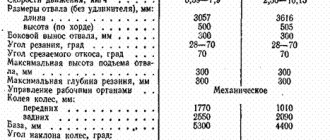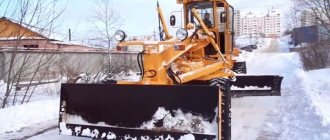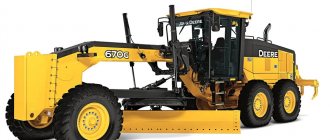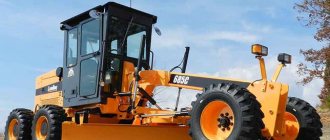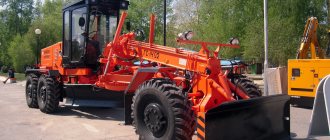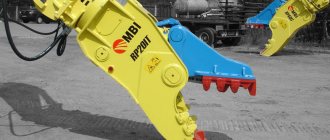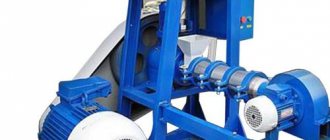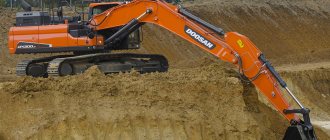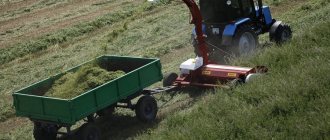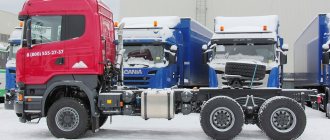Modern trailed grader: operating principle and scope of application
A trailed grader is a special type of road equipment, which is an additional equipment .
Typically, it is attached to a crawler tractor or any other pulling machine. It is used for planning, as well as profiling soil or road surfaces in small areas of application. Like the self-propelled model, it has various types of construction, as well as a type of draft class. According to this parameter, units are divided into light , medium , semi-heavy or heavy types.
Purpose of a trailed grader
Like bulldozers, graders are used to form road surfaces, construct various social infrastructure facilities and in agriculture. It is intended for carrying out such types of work as:
- Clearing and preparing small soil areas;
- Construction of small embankments;
- Construction site planning;
- Planning of embankments and slopes;
- Planning and creation of excavations or ditches;
- Leveling the road surface;
- Leveling crushed stone, gravel, sand and other building materials;
- Mixing different types of soil and creating building mixtures with various additives;
- Profiling of small dirt roads;
- Removing snow and ice crust;
- Removing construction waste from the site.
Unlike a self-propelled motor grader, it is more compact and easier to maintain. It provides significant fuel savings.
Types of graders: with mechanical (lever) control; with hydraulic control
Trailed motor graders have several classification criteria. First of all, this is the principle of operation of the mechanism, according to which they are divided into:
- With lever or mechanical control ;
- With hydraulic control .
By severity class the most common are:
- Lungs . Designed for a maximum load of 30 kN. For example, these are models DZ-6 or DZ-6A.
- Heavy . They can withstand loads from 50 to 100 kN. This category includes graders of the DZ-1 or DZ-58 brands.
Most often, tractor models such as the T-100MZ are used for light towing. To transport heavy-duty units, vehicles such as the T-130 are used.
By design they are divided into:
- Trailed;
- Semi-trailer.
In the first case, the unit has a front axle for towing. The semi-trailer does not have a rigid trailer frame connected by a ball joint.
Specifications
When selecting a specific model, it is worth considering such important technical characteristics as:
- Ground grip angle;
- Blade tilt angle;
- Cutting angle;
- Blade length.
Technical parameters of the SD model - 105 A:
- Traction force – 10 t.p.;
- Control type – hydraulic;
- Weight – 3.7 tons;
- The maximum immersion of the blade is 0.3 meters;
- The maximum tilt of the knife is 70 degrees.
Such a unit has less maneuverability and operating efficiency compared to self-propelled motor graders.
DZ 180 has the following technological characteristics:
- Traction force – 10-12 t.p.;
- Control type – mechanical;
- Weight – about 4 tons;
- The maximum immersion of the blade is 0.3 meters;
- The maximum tilt of the knife is 60 degrees.
In this case, an important advantage can be the greater cross-country ability provided by a crawler tractor.
Features of the technology
The blade is a steel plate, thanks to which the equipment can perform its functions.
One of the knives is attached to the bottom surface. The other two are fixed on the sides. The steel plate can change its position, moving along horizontal and vertical planes. The ability to change the angle of inclination helps the equipment to better perform its functions.
During operation, additional components may be used, for example, pickaxes. Their help is required during road work. The equipment is also complemented by a blade extension, a slope, a snow blower and other components.
Graders and bulldozers are similar types of machines. Moreover, the latter is considered less functional. With its help it is more difficult to make an embankment, but it will come in handy when you need to dig a pit.
Purpose and device
Like self-propelled, trailed graders, they construct the subgrade of roads and railways, and use the units in the construction of social facilities and the preparation of agricultural fields.
- clear and prepare soil areas;
- plan roadsides, slopes of embankments, excavations, construction sites;
- erect embankments of small height;
- profile unpaved and crushed stone roads;
- level, move soils, bulk materials, create building mixtures from them at the site of construction of embankments and road pavements;
- arrange ditches of small (up to 0.8 m) depth;
- They remove snow, ice crust from roads, and construction waste from sites.
Models and their prices
The most popular among builders and road operators are semi-trailer graders SD-105 A and DZ-168. They are intended for areas characterized by a temperate climate. Unlike motor graders, they have a lower speed of movement, which is 20 km/h on a flat area, mobility, but they are distinguished by greater cross-country ability.
The trailed grader DZ-168 is produced in Bryansk. It is equipped with a hydraulic control located in the tractor cabin. The latter is used T-150K or another tractor with a traction force of 30-40 kN.
- dimensions - 6.03x2.4x2.4 m;
- dump dimensions: length - 3.74 m, height - 0.62 m;
- the distance of the blade to the side is 0.8 m;
- cutting angle with a soil dump - 30-70°;
- ground clearance - 0.35 m;
- the blade can be maximally buried in the ground by 0.25 m and rotated 360°;
- weight - 3.35 tons.
The SD-105A trailed grader is the brainchild of an experimental plant from Volgodonsk. Suitable for profiling elements of dirt roads and agricultural fields. It is controlled hydraulically by the tractor driver. Used in conjunction with tracked and wheeled tractors (T-150K, DT-75, K-701). The blade of the machine can be installed at an angle to the surface of the developed soil (building material) - 28-60.
- designed for traction force - 100 kN;
- weighs - 3.37 tons;
- with dimensions - 6.2x2.5x2.2 m;
- with welded base frame, side blade mechanism;
- with a blade immersion depth of 0.3 m, the possibility of its removal to the side by 0.7;
- length and height of the blade - 3.66 and 0.64 m, respectively;
- with blade rotation 260°;
- with clearance - 0.30 m;
- is distinguished by comfort and reliability;
- has high mobility;
- can be additionally equipped with: balancer; additional wheels; ripper-picker.
Prices for new trailed graders start from 803 thousand rubles. Used units can be found for 132 thousand rubles.
Graders based on MTZ | MTZ-80 | trailed motor grader | price
Belarusian MTZ tractors are widely used in Russia and the CIS countries, thanks to the unique combination of simplicity and reliability with power and performance. Many modifications of special equipment, including graders, have been created on the basis of agricultural machines.
Grader based on MTZ: features
Like the base machine, the MTZ grader has impressive performance characteristics. The equipment is produced by the Bryansk Arsenal concern and is produced in the form of a full-fledged road construction version. The grader is based on the chassis of one of the famous Belarus tractors. A grader blade, a bulldozer blade and related equipment for controlling the working bodies are installed on the chassis.
The MTZ motor grader compares favorably with its counterparts by the presence of a rear linkage system. This allows the manufacturer to equip the machine with additional functions without significant changes in design. For example, the GS 10.08 grader is used in the municipal sector, for which a corresponding working element is installed on the rear linkage.
Another advantage of graders based on MTZ is their low cost. Special machines for road construction, mounted on specialized chassis, are very expensive for buyers. At the same time, the Belarus tractor offers time-tested and experience-tested technical data at an affordable price. At the same time, the buyer receives a guarantee of equipment reliability, which is typical only for Belarusian tractors.
A trailed grader for MTZ can be placed in a separate class. This technique has its drawbacks. Large dimensions reduce the maneuverability of the machine. To use working equipment, a separate mechanical or hydraulic drive is required. However, the versatility of Belarus tractors allows the use of trailed devices in conjunction with basic equipment without any particular inconvenience.
Grader based on MTZ-82
Currently, Bryansk Arsenal produces two main models of graders based on MTZ. This is GS 10.01 based on the well-known MTZ-80 and GS 10.08 based on the universal and powerful MTZ-82.
The GS 10.08 motor grader is installed on the MTZ-82 chassis and uses key components and assemblies of the tractor to perform construction operations. The base machine's eight-speed standard transmission allows the grader blade to be used at the desired speed, both forward and backward. The gearbox is equipped with a reverse gearbox, which for construction equipment means the ability to quickly change the direction of work.
The maximum speed of the grader reaches 20 km/h in transport position. The operating speed of the machine is 1.68 km/h. The equipment uses the base engine of the D-243 tractor with an operating power of 80 hp. The working body is controlled through hydraulic cylinders from the driver’s cabin.
Performance characteristics
The GS 10.08 motor grader based on the MTZ-82 is basically unified with the tractor. The equipment is equipped with a grader blade 2800 mm long, providing soil cutting angles of 40 and 60 degrees. The rear linkage system of the base tractor is used to install a brush for cleaning roads and sidewalks. The working width of the equipment is 1800 mm, productivity reaches 21,600 m2/h.
In addition to the rear linkage and grader equipment, the tractor is equipped with a front dozer blade with a soil cutting depth of up to 100 mm. The rear attachment can be changed to any working tool that is compatible with the Belarus tractor linkage.
dimensions
- length - 6450 mm;
- width - 2300 mm;
- cabin roof height - 2850 mm;
- wheelbase - 5000 mm;
- blade base - 1680 mm;
- turning radius - 8.65 m;
- operating weight - 6800 kg.
Get an advantageous offer from direct suppliers:
You might be interested
spectehnika-info.ru
Where are trailed graders used?
Graders towed by tractors were created as earth-moving machines for forming road surfaces and preparing the surface for laying asphalt and concrete. Trailed units are also used in the construction of industrial buildings, social infrastructure facilities, in agriculture and public utilities:
- for creating embankments, profiling their surface;
- in leveling road surfaces in dirt and embankment;
- when mixing crushed stone, gravel materials, soils of various categories with each other and with binding additives;
- for planning according to design marks of land plots, slopes, excavations, ditches;
- in distribution over the surface of the working area and leveling the layer of crushed stone, gravel, sand materials;
- when working in the public sector, including snow removal and garbage collection.
TOP 2 trailed graders SD-105 A and DZ-168: let’s look at them in general terms
Minimum order: 0 pcs.
Description
The semi-trailer hydraulic grader SD-105A is a good replacement for motor graders for performing excavation work during the construction, repair and maintenance of highways, as well as for planning fields and roadsides in agricultural conditions.
The SD-105A semi-trailer grader is used with the widely used tractors T-150K, K-700, K-701, DT-75, MTZ 1221.
Where are trailed graders used?
Graders towed by tractors were created as earth-moving machines for forming road surfaces and preparing the surface for laying asphalt and concrete. Trailed units are also used in the construction of industrial buildings, social infrastructure facilities, in agriculture and public utilities:
- for creating embankments, profiling their surface;
- in leveling road surfaces in dirt and embankment;
- when mixing crushed stone, gravel materials, soils of various categories with each other and with binding additives;
- for planning according to design marks of land plots, slopes, excavations, ditches;
- in distribution over the surface of the working area and leveling the layer of crushed stone, gravel, sand materials;
- when working in the public sector, including snow removal and garbage collection.
In all work where it is necessary to level the surface and make it uniform, the use of grader devices is effective and economically justified.
Types of graders: with mechanical (lever) control; with hydraulic control
Trailed motor graders have several classification criteria. First of all, this is the principle of operation of the mechanism, according to which they are divided into:
- With lever or mechanical control ;
- With hydraulic control .
By severity class the most common are:
- Lungs . Designed for a maximum load of 30 kN. For example, these are models DZ-6 or DZ-6A.
- Heavy . They can withstand loads from 50 to 100 kN. This category includes graders of the DZ-1 or DZ-58 brands.
Trailed and semi-trailer units - what are the differences?
In a trailed grader, a traction frame with a rotating circular mechanism and a blade are mounted between the front axle and the rear axle on the main frame. The wheel axle is connected to the tractor's towing bracket by a drawbar. The operator controls the installation of the blade using a steering mechanical drive or levers of the spool device of the hydraulic system.
Figure 1 Trailed grader with driver steering control
A semi-trailer grader usually does not have a front axle and the length of the machine is shorter. The main frame is connected to the tractor hitch via a ball joint assembly. The hydraulic drive of the blade installation is controlled by the operator of the traction tractor.
Both units are towed by a tracked or wheeled tractor. The cost of towed devices is significantly lower than their self-propelled counterparts.
Figure 2 Tractor T-150 and semi-trailer hydraulic grader SD-105A
The trailed grader is structurally complex and ineffective in use. The disadvantage is that, in addition to the tractor driver, the operator of the unit controls it. Similar machines with a steering mechanism for mounting the blade are no longer produced and have been replaced by more productive semi-trailer graders with hydraulic drive of the executive equipment, controlled by the tractor operator:
- SD-105A for traction tracked and wheeled vehicles DT-75, T-150K, K-701;
- DZ-168 for the T-150K tractor.
The SD-105 chain grader will pull it MTZ 82.1-23?. Page 2 of 2
Sergey, what do you think, the circle will be weak from the Ptski. And take the frame from 2pts4 only from a semi-trailer.
you can do it from anything - I had such material and collected it from it. The circle and from the Ptski should withstand. The main thing is to attach the bridge to the frame without springs and the frame so that it can swing from side to side. If this is not done, then you will have to do it a more complex mechanism with the tilting of the blade itself like a grader - on two cylinders.
Sorry, there are no photos on the hundred-foot-long rower... but there are wheels from a six-ton cart... or the same ones are on the hundred-foot trailer
MTZ definitely won’t be able to handle it in work. It will crap when collecting soil or snow with such a blade width. The tractor declared by the factory is no lower than 1221. The graders on the trucks also came in different ways - both with a hook on the hitch triangle and with landing on the rear semi-frame - that one is quite heavy and they hooked it up with a crane once and for the whole winter or until it broke down - an acquaintance with one of these was dragging around on a tesik. On the neighboring collective farm it was easier with a hook on a square - they tried to put a little thing under it - it stood on the sprockets - where is the MTZ.
If you are making a complex mechanism, you need to guess the angle of attack so that the knife can remove a layer of soil, or adjust it by lifting the attachment so as not to install a third cylinder. And in order for the bridge to tilt, you need to weld a box with bushings and a connecting pin to the axle. For example, you can take the pipe of an MTZ80 bridge, weld it to the ends of the axle under the hub and there will be a swing axle. How much stroke is needed for the swing angle of the axle?
Born to crawl, he cannot fly.
Sergey, what do you think, the circle will be weak from the Ptski. And take the frame from 2pts4 only from a semi-trailer.
you can do it from anything - I had such material and collected it from it. The circle and from the Ptski should withstand. The main thing is to attach the bridge to the frame without springs and the frame so that it can swing from side to side. If this is not done, then you will have to do it a more complex mechanism with the tilting of the blade itself like a grader - on two cylinders.
Sorry, there are no photos on the hundred-foot-long rower... but there are wheels from a six-ton cart... or the same ones are on the hundred-foot trailer
MTZ definitely won’t be able to handle it in work. It will crap when collecting soil or snow with such a blade width. The tractor declared by the factory is no lower than 1221. The graders on the trucks also came in different ways - both with a hook on the hitch triangle and with landing on the rear semi-frame - that one is quite heavy and they hooked it up with a crane once and for the whole winter or until it broke down - an acquaintance with one of these was dragging around on a tesik. On the neighboring collective farm it was easier with a hook on a square - they tried to put a little thing under it - it stood on the sprockets - where is the MTZ.
If you are making a complex mechanism, you need to guess the angle of attack so that the knife can remove a layer of soil, or adjust it by lifting the attachment so as not to install a third cylinder. And in order for the bridge to tilt, you need to weld a box with bushings and a connecting pin to the axle. For example, you can take the pipe of an MTZ80 bridge, weld it to the ends of the axle under the hub and there will be a swing axle. How much stroke is needed for the swing angle of the axle?
Born to crawl, he cannot fly.
If you are making a complex mechanism, you need to guess the angle of attack so that the knife can remove a layer of soil, or adjust it by lifting the attachment so as not to install a third cylinder. And in order for the bridge to tilt, you need to weld a box with bushings and a connecting pin to the axle. For example, you can take the pipe of an MTZ80 bridge, weld it to the ends of the axle under the hub and there will be a swing axle. How much stroke is needed for the swing angle of the axle?
in general, I didn’t measure how much would be needed, I did everything at random and see how it would turn out. It turned out well. In the process there were some finishing touches and alterations along the way. At first I installed a narrow bridge with the SK5, but with it the tail was thrown into the oncoming traffic. To add additional load, I installed a bridge with wheels the beam is wide and we managed to fit two counterweights from the tractor onto it. Now you can hydraulically raise the wheel by 10 centimeters by resting the knife on the ground and pressing the drawbar with a hitch. Maybe it will work out more - I didn’t measure it and there was no need. The angle of attack of the knife changes - for cleaning roads from snow are at one angle, soil grading is at a different angle. That is why the tilt of the blade is desirable from the cylinder. And the swing of the frame is necessary so that when lowering the linkage (all work goes through the linkage - a long one with a square) it is possible to adjust the position of the knife on the road surface - press the right or left corner of the blade, depending on what needs to be done - raise or lower the curb.
Trailed grader SD-105A
The SD-105A trailed grader is designed to perform leveling, profiling and other earthworks during the construction, repair and maintenance of road surfaces, roadsides, and preparation of sites and fields for agricultural purposes. The grader is made according to a semi-trailer design with a balancing trolley.
The base tractor for the SD-105A semi-trailer grader can be the T-150K, K-700, K-701, DT-75, MTZ-1221 tractor, as well as foreign equipment from the brands JCB, John Deere, CASE, Caterpillar, New Holland and any others with towing class 2 or more, equipped with a standard 3-point hitch. Coupling with the tractor is carried out using a 3-point rear linkage of the tractor. Thanks to this, high mobility of the semi-trailer grader is achieved. The SD-105A trailed grader is controlled by the operator from the cabin of the base tractor using a hydraulic system connected to the hydraulic drive of the base tractor.
The main consumers of this grader are agricultural firms and agricultural holdings, livestock farms, forestry, road repair and construction departments. The use of trailer graders is effective in many types of work where the use of self-propelled graders is impractical from both practical (scope of work, maintenance, storage of a piece of equipment) and economic (high cost of acquisition and ownership) points of view.
The grader is a universal machine for road work
To reduce the load on people during repairs and other types of work on roads, special machines were developed and manufactured. A grader is one of these vehicles. This is a universal unit with which road workers and builders can cope with heavy work faster and more efficiently.
What it is?
The word grader or grade, which is used in the name of the machine, translated from English means “leveling” or “levelling”. That is why a grader is a special vehicle (less commonly a towed device), which is designed to measure slopes, unevenness of the road surface (soil, crushed stone, sand, etc.), as well as give it the required shape.
Differences between a grader and other special equipment
Sometimes many people mistakenly believe that a grader is a special machine that is similar to a scraper or bulldozer. For example, in English, road scraper and grader are considered synonyms. Although this is extremely false. Using a scraper, you cannot profile areas and slopes on roads, as well as perform a number of other operations. They are used only for cutting small layers of soil.
The same applies to such special equipment as a bulldozer. With its help, you can only clear a road or construction site from excess soil and debris, as well as dig a pit.
Design and principle of operation
This equipment is equipped with special blades that are mounted on the frame of the machine itself. Such working parts of graders are adjustable in two directions (horizontal and vertical), thanks to which the required level of leveling can be achieved. The driver operates the vehicle blades from the cab using hydraulic or mechanical control. But there are also graders equipped with auto platforms that allow them to move independently.
During road repair work, modified special equipment is used (the grader is supplemented with special working parts and picker workers). Such units can, among other things, loosen the top layer of the road surface.
Types of graders depending on design features
It was already said earlier that, in addition to standard graders, there are also modified models that differ in both power and separately installed devices.
Depending on the design features, such special equipment can be:
- Self-propelled (motor graders, which were already mentioned earlier). In addition to the platform, pickers and main working parts, such machines are equipped with snowplows, bulldozer blades and their extensions, which are driven by an engine drive using mechanical or hydraulic control.
- Semi-trailer. For these types of graders, most of the load is transferred to the conveyor frames. Such a unit is more maneuverable than a trailed grader, but also not as productive. In addition, another disadvantage of such machines is that their towing force on the coupling in most cases does not exceed 10 tons.
- A trailed grader, which is used as an additional equipment for a tractor. To fully use such a device, two people are needed - a tractor driver and a grader operator. Such devices have low performance and maneuverability, but show excellent results in off-road conditions. In addition, towed devices are cheaper than self-propelled units.
Types of graders depending on technical characteristics
Self-propelled vehicles also have their own classification, as do individual towed devices. Eat:
- Light grader. The technical characteristics of such a machine allow it to be used only for road repairs. The engine power of a light motor grader is only 70-75 hp. With.
- Medium with engine power up to 100 hp. With.
- Heavy (from 160 to 180 hp). Such special equipment can be used both for road repair and in the construction industry.
- Super heavy motor grader, the power of which can reach more than 400 hp. With.

